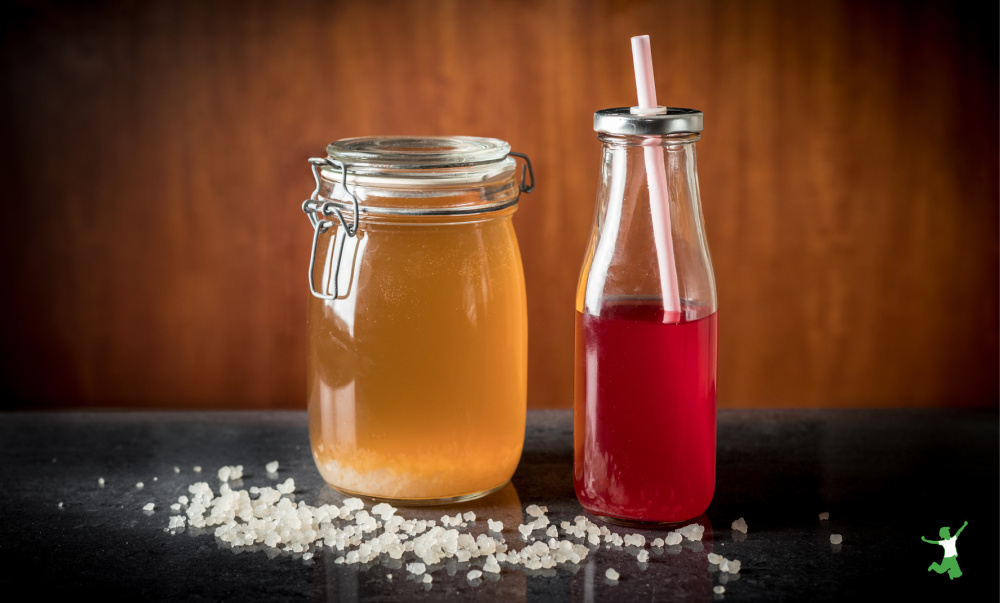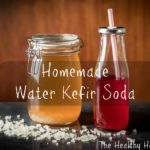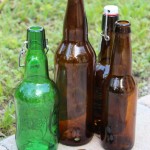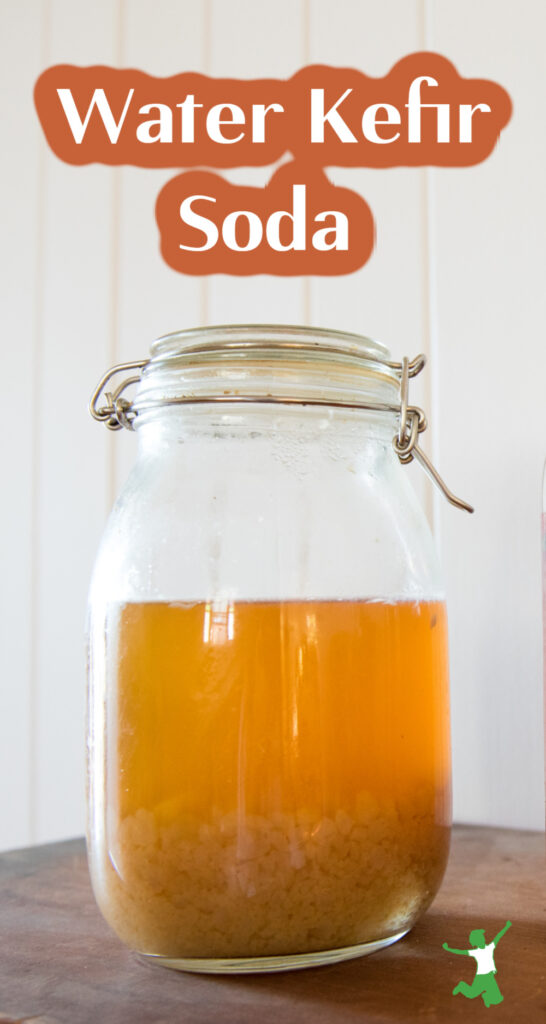How to make bubbly, fermented water kefir which is a traditional cultured beverage loaded with probiotics and enzymes. A healthy alternative to soda.

Many people are surprised to learn that soda is actually a traditional food! Of course, ancestral cultures did not sweeten fermented beverages artificially or add unhealthy chemicals and GMO sugar like today.
Water kefir is a very popular example of a healthy traditional beverage that is tasty, fizzy, satisfying and thirst-quenching without any of these additives.
Many people are familiar with homemade dairy milk kefir or coconut milk kefir. Be aware that a slightly different type of culture is used to make water kefir.
Water kefir grains look different than milk kefir grains. They also grow much faster, which is great because there is more to share with your friends!
The probiotic properties of water vs milk kefir grains vary quite a bit as well.
You should be able to procure some water kefir grains within your local community by asking your health-conscious friends or at farmers’ markets.
If you still cannot find some locally, you can order them from the vetted sources in my shopping guide.
If you wish additional flavor and fizz, be sure to bottle your homemade water kefir after it is finished culturing.

Homemade Water Kefir Recipe
Bubbly, homemade water kefir recipe that the whole family will enjoy to help kick the unhealthy soda habit once and for all!
Ingredients
- 1/4 cup water kefir grains
- 1 quart filtered water
- 1/4 cup sucanat
Instructions
-
Mix all the ingredients together in a mason jar leaving 1 inch at the top.
-
Screw on the lid and leave on the counter for 48 hours. Taste after 48 hours, and if it is too sweet, leave for another 24 hours. Taste again, if too sweet, leave another 24 hours. Repeat for up to 5 days until the a fermented, apple cider type flavor with minimal sweetness has been achieved.
-
Strain out the water kefir grains and refrigerate the liquid (no metal please), clean the mason jar, and repeat the process for a new batch of water kefir. You will have approximately double the kefir grains as they grow rapidly with each batch. You can give them away, eat them as a live probiotic, or make a larger batch of water kefir.
-
To add variety, you may also reduce the sugar to 1/8 cup, reduce the water to 3 cups, and add 1 cup of fresh fruit juice. Juice from the store is almost always pasteurized and as such, is not recommended as it significantly increases the risk of fermentation mold. Fresh juice has minimal mold issues when fermented and is much more nutritious, and is therefore best to use. If using fresh lemon or lime juice, keep the sugar at 1/4 cup and only use 1/2 cup fresh juice.
-
After fermenting, you may bottle the liquid to achieve extra fizz. This is an optional step. The picture with this step shows the types of bottles I use. Only fill the bottles to the bottom of the neck and leave on the counter for and additional 24-48 hours.

-
Chill well and open the bottles slowly over the sink as the level of carbonation is quite surprising!
-
To store your water kefir culture, place up to 1/2 cup water kefir grains in 1 quart of filtered water mixed with 1/4 cup sucanat, coconut sugar, or maple sugar and refrigerate until you are ready to use again.
Recipe Video
Recipe Notes
Maple sugar or coconut sugar may be substituted for the sucanat. Raw honey does not work as well in my experience.









Hi Sarah,
I have been diagnosed with a few food allergies such as bakers and brewers yeast. I know the kefir produces yeast to eat the sugar. Having an allergy to yeast would this affect me when I drink it? Is any yeast left in the beverage?
Thanks for all of your videos. They are great information.
You should be fine with raw kefir … the beneficial bacteria consume the lactose (milk sugar).
I’ve been making “grape soda” for about 8 months now. I make my “sugar water”, put my kefir grains in and let them sit on the counter for 1 to 1 1/2 days. I then filter out the grains and bottle the liquid into grolsch-type bottles with about 1/4 cup organic grape juice and let them sit on the counter for another day or so. The kids love it! And I do too! ; )
Hi Sarah
I’ve just recently started watching you on You-Tube. Love all your videos, very informative, educational and inspiring.
As a probiotic drink which would say is superior, Kombucha or Water Kefir.
Thanks.
Hello, I love the water kefir idea. I used to dabble in homemade cheeses, and I learned about milk kefir at that time, but never have had a chance to try it. I never knew about water kefir until I saw this video. Thank you for the helpful info. 🙂
Hi Sarah,
I want to start making water kifer and you had a few suggestions for sugars in the brew. We sweeten (almost) everything with honey. If I decide to ferment the grains in honey, how much should I use instead of the 1/4 cup of sugar?
Thank you! 🙂
Honey is an antibacterial and will not work in your water kefir. It will eat the good bacteria and leave you with sick grains. It will taste good but you won’t get the benefits of probiotics in your yummy drink.
It’s not true that honey kills beneficial bacteria, its exactly the opposite. Honey is a prebiotic
ncbi.nlm.nih.gov/pubmed/11808799
” Honey enhanced the growth of the five cultures much like FOS, GOS, and inulin did. Honey, FOS, GOS, and inulin were especially effective (P < 0.05) in sustaining the growth of these cultures after 24 h of incubation as compared with the control treatment. Overall, the effects of honey on lactic and acetic acid production by intestinal Bifidobacterium spp. were similar to those of FOS, GOS, and inulin."
====
bmccomplementalternmed.biomedcentral.com/articles/10.1186/1472-6882-6-6
"….On the other hand, the colon bifido bacteria and lactobacilli counts were increased markedly in group receiving diet supplemented with honey.".
Conclusion- Substituting sugars with honey in processed food can inhibit the harmful and genotoxic effects of mycotoxins, and improve the gut microflora.
======
researchgate.net/publication/227541373_Growth_and_Acid_Production_by_Lactic_Acid_Bacteria_and_Bifidobacteria_Grown_in_Skim_Milk_Containing_Honey
"Although lactic acid production was enhanced (p , 0.05) when bifidobacteria were grown in the presence of honey, acetic acid production was not affected. Various oligosaccharides found in honey may be responsible for enhanced lactic acid production by bifidobacteria.
Hi Sarah,
I want to know more about your water filter and the reasons for a water filter. I have looked for information to see if you have ever blogged about this but cannot find one. Can you please discuss the benefits of filtered water, as well as brands of water filters you recommend?
I’m planning to start making kefir, but am wondering should I make both water and milk kefir? Or is one better than the other for health and nutrition value? I have been making yogurt and Kombucha, and plan to continue.
Just received my water kefir grains. Took three weeks to get here and after a long wait I am so disappointed. I was supposed to receive this beautiful dehydrated culture and all I got was this disgusting looking water with just a couple of kefir grains in it. Yuck
Help! I started making water kefir the end of July and everything was great for months. I only added natural cane sugar and a little baking soda for some added minerals but now I’m continuing to have kefir water that seems a little thickish. I’ve stopped with baking soda but it’s still thickish. I’ve tried a few online remedies but things haven’t improved. What is going on?
my water kefir started to be thickish too. What did you find out? What is the reason? Thanks.